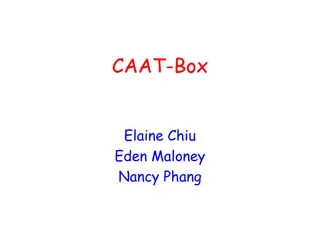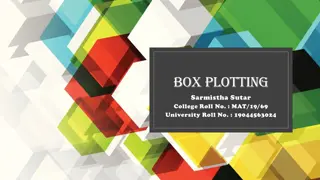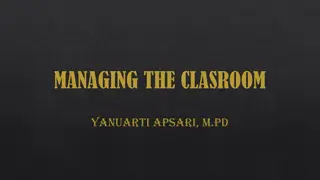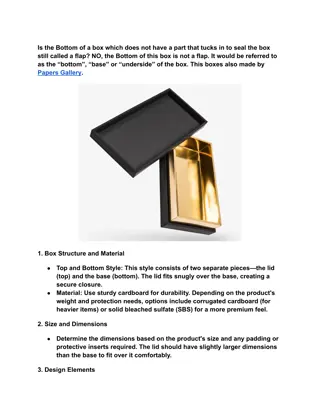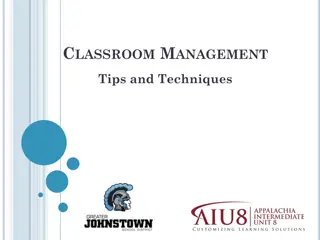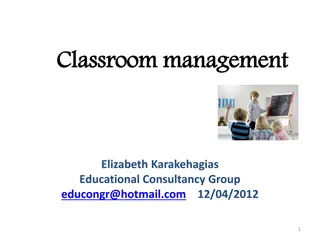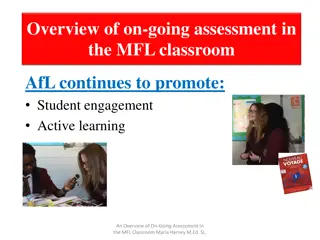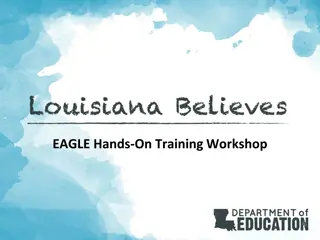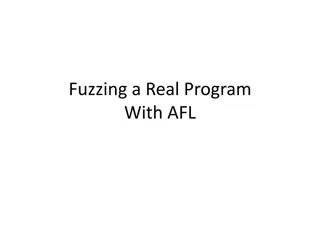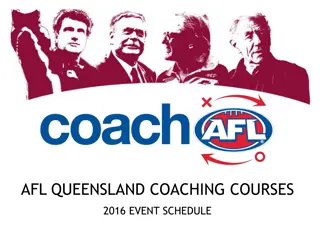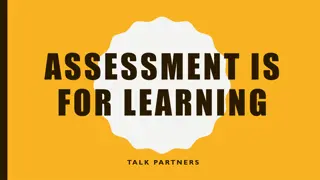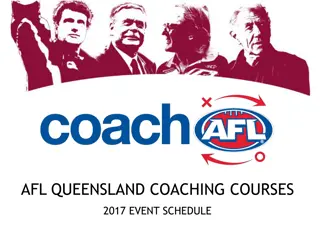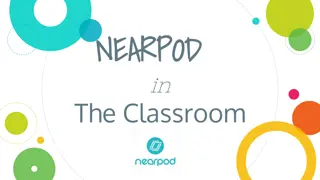Create Your AFL Box for Effective Classroom Assessment
This comprehensive guide provides step-by-step instructions and printable resources to help you set up an AFL (Assessment for Learning) box in your classroom. From Traffic Light Cards to Ready-to-use Plenaries, this resource equips you with tools to engage students in assessment practices. Enhance your teaching strategies with this practical toolkit designed by Mike Gershon.
Download Presentation

Please find below an Image/Link to download the presentation.
The content on the website is provided AS IS for your information and personal use only. It may not be sold, licensed, or shared on other websites without obtaining consent from the author. Download presentation by click this link. If you encounter any issues during the download, it is possible that the publisher has removed the file from their server.
E N D
Presentation Transcript
Make Your Own Box Everything you need to create an AFL Box for your classroom (or someone else s). Made by Mike Gershon mikegershon@hotmail.com www.tes.co.uk/mikegershon
Contents Instructions on how to use this document 1, 2, 3, 4 Cards Traffic Light Cards A, B, C, D Cards Tick and Cross Cards Ready-to-use Plenaries Ideas on how to use the Plenaries Ways to do Whole-Class Feedback List of Resources and where they can be purchased
Instructions on how to use this document This document contains everything you need to create an AFL box for your classroom, or for classrooms throughout your school. An AFL box is a physical box containing items and equipment connected to assessment for learning. The teacher can use these to embed AFL in their teaching. Here is a suggestion on how to use each part of this document: 1, 2, 3, 4 Cards Print off enough for a class set. Laminate them and clip them together. Hand them out to students and display questions with four possible answers. Pupils can then hold up the card which they think indicates the correct answer. Traffic Light Cards Print off enough for a class set. Give each student a red card, an orange card and a green card. Ask them to display the card which most matches where they are at. Green = I am confident and know what I am doing; Orange = I am OK but might need some help; Red = I do not understand and cannot do the work. A, B, C, D Cards As with the 1, 2, 3, 4 cards. Tick and Cross Cards Print off enough for a class set. Create cards which have a tick on one side and a cross on the other. Laminate them. Hand them out to students and display questions which have yes/no or agree/disagree answers. Ask pupils to show you what they think is the right answer. The above four elements are all examples of whole-class feedback techniques. Ready-to-use Plenaries Print these off an laminate them, then place them in the box. The teacher can call on them at the end of any lesson. Supplement them with the Ideas on how to use the Plenaries sheet. Ways to do Whole-Class Feedback Print this section off using the hand-outs setting in PowerPoint (available when you go to print). Laminate the sheets and place them in the box. The teacher can refer to them before, during or after lessons. List of Resources - None-electronic resources which you can buy to put in your box, along with explanations of how to use them.
1 2 3 4 1 2 3 4 1 2 3 4 1 2 3 4 1 2 3 4 1 2 3 4
A B C D A B C D A B C D A B C D A B C D A B C D
150 Plenary Questions and Tasks for use in any subject 1. What have you learnt today? 2. What is the most important thing you have learnt today? 3. What do you know now, that you did not know at the start of the lesson? 4. How has your understanding changed as a result of the lesson? 5. What three things have you learnt today? 6. What would you choose as the key thing you have learnt today? Why? 7. What do you want to know as a result of what we have learnt today? 8. What can you do now, that you could not do at the start of the lesson? 9. How has today s lesson changed you knowledge or understanding? 10. What questions do you have, based on today s lesson? 11. Why do you think we have studied what we have studied this lesson? 12. How might you change today s lesson for future students? Why? 13. How might you use your learning from today s lesson in the future? 14. What has been the purpose of today s lesson? 15. How might you use what you have learnt today? 16. If you were going to teach this lesson to younger students, what would you identify as the key things they would need to know? 17. Based on what we have learnt today, what do you think we should study next? Why? 18. Where might you make use of the learning you have done today? 19. Under what circumstances, or for what reason, might we need to use today s learning? 20. How might you test one of your peers to see what they have learnt today? 21. How might you explain what you have learnt today to your parents? 22. How might you explain what you have learnt today to an alien?
23. How might you explain what you have learnt today to someone younger than yourself? 24. What connections can you make between today s learning and what we have studied previously? 25. How does today s learning connect to what you already know? 26. How might today s lesson have been different? What might have been the result of this? 27. How might we have learnt the same things, but in a different way? 28. Who might use what we have learnt today in their daily lives? 29. How have you worked today? Why? 30. How might you improve your learning next lesson? 31. What have been the strengths and weaknesses of this lesson? 32. What skills have you used during this lesson? 33. What skills have you improved during the lesson? How have you improved them? 34. What knowledge have you gained this lesson? 35. How might you use the knowledge you have gained in this lesson in the future? 36. How have you interacted with your peers during this lesson? 37. What strengths and weaknesses have you seen in yourself this lesson? 38. What changes might you make next lesson to how you work? 39. How has today s lesson made you feel? 40. To what extent do you feel you have engaged with the lesson today? Why? 41. To what extent do you feel you have learnt in today s lesson? Why? 42. How have you learnt this lesson? 43. In what way(s) has your mind been changed by today s lesson? 44. If you were to go back in time and start today s lesson again, what would you change and why? 45. How could you have done things differently this lesson? What affect might this have had?
46. How did you feel at the beginning, middle and end of the lesson? 47. How have you used you existing skills and knowledge in today s lesson? 48. What have you done well this lesson and why? 49. Write a poem about what you have learnt today 50. Create a short story based on today s lesson 51. Write a set of five questions based on today s lesson and then use them to interview you partner 52. Draw a picture showing what you have learnt today 53. Draw a cartoon strip showing what you have learnt today 54. Draw a cartoon strip showing how you will use today s learning in the future 55. Write a letter to one of next year s students explaining what today s lesson is about 56. Write a speech persuading people that what we have learnt today is important 57. Produce five key points which sum up today s learning 58. Create a mind-map showing what we have learnt today 59. Create a set of instructions for today s lesson which anybody could follow 60. How might you combine today s learning with something else you already know? 61. What existing skills or knowledge could you combine today s learning with? 62. Write a song or rap about what we have learnt today 63. Create a poster advertising today s learning to other students 64. Create a television advert selling today s learning 65. Create a radio advert selling today s learning 66. Create a quiz, based on today s learning, which you could use to test other students 67. Explain what we have learnt today without using words 68. Create a short presentation explaining the key points from today s lesson
69. Create a leaflet about what you have learnt today 70. Write a letter to a person in the nineteenth-century explaining what you have learnt today 71. Write a message to an alien explaining what you have learnt today 72. Use symbols to show what you have learnt today 73. Make a model of one aspect of your learning 74. Sculpt one of the key ideas from today s lesson 75. Construct a timeline showing your learning through the lesson 76. Swap your work with a partner and assess it: What have they done well? How might they improve? 77. Assess your own work: What have you done well? How might you improve? 78. What strengths have you shown in today s lesson? What areas for improvement can you find? 79. Find a partner who you don t often work with. Swap your work and do a peer-assessment. Identify three strengths and one target for improvement. 80. What is the most important thing we have learnt over the past few lessons and why? 81. Write down all the things we have learnt today. Once you have done this, order them according to how important you believe them to be. 82. How would you have taught today s lesson and why? 83. What difficulties have you encountered today? How have you dealt with them? 84. What difficulties might a student encounter if they were new to today s topic? 85. Assess your learning using the learning objective: Have you met? How? If not, what do you still need to do in order to meet it? 86. What evidence do you have showing what you have learnt today? 87. What key question would you ask to find out whether someone has understood today s lesson? 88. Write an exam-style question and mark-scheme based on today s lesson
89. Write three key questions you think people in the class should be able to answer, based on today s lesson. When ready, walk round and ask people your questions. 90. Identify the key learning points from today s lesson 91. Compare what you know now with what you knew at the start of the lesson. How is it different? 92. Write a quiz based on today s lesson. Make sure you cover all areas. When you are ready, test your partner. 93. What different possibilities can you imagine for next lesson, bearing in mind what we have learnt today? 94. Pick one thing you have done today and identify how you could do it better 95. Pick one thing you have done today identify why it was good and how it helped you 96. How useful is what we have learnt today? Why? 97. Write what you have learnt today on a piece of paper and hand it in on your way out 98. If you feel you have fully understood the lesson, give a thumbs up . If you feel you have understood most of it, turn your thumbs sideways. If you feel you have struggled to understand it, give a thumbs down . 99. Think about today s lesson. Give yourself a score between 1 and 5. 1 = I have really struggled and need more help. 5 = I have understood nearly everything and could explain to others. Once you have done this, find someone with a different score. Either ask them for help, or offer them help. 100. Write down the questions you still have about the topic, and which you do not feel have been answered yet. 101. What criteria would you use to judge whether someone has fully understood the lesson today? 102. How does today s lesson connect to your existing knowledge? 103. How does today s lesson connect to our previous areas of study? 104. How might today s lesson connect to other areas of the curriculum? 105. Write down what you think is the most important thing you have learnt today, and then hold it up for everyone to see
106. Draw a line and label it from one (no idea) to ten (completely understand). Indicate where you feel you were at regarding the topic when the lesson began, and where you feel you are at now. Then, explain your choices. 107. Work in a group of three or four to create a freeze-frame showing the key thing you have learnt today 108. Work in pairs. Take it in turns to mime key ideas and information from the lesson. The other person has to guess what is being mimed. 109. Create a short role-play in which someone s life is changed through learning what we have learnt today 110. Create a pair of still images showing life before and after what we have learnt today 111. Work in groups. Create a role-play showing what life would be like if no one knew about what we have learnt today. 112. Work in pairs. Create a thirty-second sales pitch for today s learning which could be used on a television shopping channel. 113. Work in pairs. One person is the interviewer. The other person has had their life changed by what we have learnt today. Conduct an interview for the BBC news using these roles. 114. Work in groups of three or five. One person is the chairperson. The rest split between for and against. The motion is: Today we have learnt some incredibly important things . The debaters must argue the point while the chairperson referees. 115. Work in pairs. Each person, in secret, chooses an emotion. Next, conduct a discussion about what we have learnt today, while playing that emotion. When the teacher says, continue the discussion but swap your emotions. 116. Work in groups. Turn today s lesson into a dramatic story. One person reads the story aloud while the rest of the group act it out. 117. Write a postcard to a friend explaining what you have learnt this lesson. Draw a picture for the front showing what you have learnt. 118. Write a text message explaining what you have learnt this lesson 119. Choose three keywords we have used this lesson. Write a definition for each and then give an example.
120. Choose one thing you have done this lesson and redo it so that it is better 121. Plan your own lesson covering what we have studied today 122. Compare what you have learnt this lesson with what you learnt last lesson. How is it similar? How is it different? 123. Write a list of what you have learnt today. Give examples for each item so as to show your understanding. 124. Produce a summary of what you have learnt today. When done, rewrite it using fewer words. After that, reduce it to either a single sentence, or three bullet points. 125. In pairs, discuss what you have learnt this lesson. Be ready to share your thoughts. 126. In pairs, assess your work. Take it in turns to go through and identify the strengths and one area for improvement in your work, and in that of your partner. 127. In pairs, take it in turns to interview one another about today s lesson. Take notes as you go. 128. In pairs, produce a list of key words and definitions which link to today s lesson. Then, jumble them up and challenge another pair to match the correct word to the correct definition. 129. In pairs, discuss how you think what we have learnt today is used in the wider world. Be ready to feed back to the whole class. 130. In groups of three or four, take it in turns to try and talk for a minute about today s topic without pausing or repeating yourself. 131. In pairs, one person is for and one person is against . The motion is: What we have learnt today is extremely important. The people for will go first, for a minute. The people against will get a minute after that. Finally, there will be a minute of free-for-all, where both sides can speak. 132. Take it in turns to draw something connected to today s lesson. The other person must try to guess what it is. The drawer is not allowed to talk, or to write any words. 133. In groups of three or four, discuss what you have learnt this lesson. Appoint one person as the leader. It will be their job to share your group s ideas with the rest of the class. 134. In groups of three or four, identify what you think are the three most important things we have learnt today. Elect one representative. They will travel to other groups and try to persuade them of your views.
135. In groups of three or four, produce a role-play based on something we have learnt today. 136. Write a possible exam question based on today s learning. Swap books with a partner and attempt their question. 137. Write a possible exam question based on today s learning. Then, write a model answer. 138. Write a series of multiple choice questions based on today s learning. Swap books with a partner and attempt their questions. 139. Draw between three and five key concepts or ideas linked to today s lesson. Do not label them. Swap books with a partner and try to identify what the concepts or ideas are. 140. Write three possible exam questions based on today s learning. Walk around the room and ask your questions to other students. Discuss their answers with them. 141. In groups of three or four, write a short summary of everything we have learnt today. Produce a series of appropriate actions to go with your summary. One person will read the summary out to the class while the rest of your group do the actions. 142. Write a question, based on today s topic, with which you think you can beat the teacher. 143. How might you translate today s lesson into a graph? 144. How might you explain what we have learnt today using symbols? 145. How might you express what you have learnt today using your body? 146. What do you feel you have got from today s lesson? 147. What would you like us to study next and why? 148. Why might people have decided that it is important for young people to know about what we have studied in today s lesson? 149. Where might you use today s learning in the next month? 150. How would you describe your experience of today s lesson using colours and shapes?
Ways in which you might use the plenary material: Transfer a question or task to a PowerPoint or Interactive Whiteboard slideshow. Keep the sheets on hand in your classroom and select questions or tasks which suit the flow of the lesson. Invite a student to select a number between 1 and 150. Use the corresponding task or question as your plenary. Create a grid of 150 numbered squares. Invite students to throw a counter onto the grid. The number on which the counter lands is the plenary. Create a collection of slips of paper number 1 150. Place these in a bag, hat or container. Invite a student to select a slip at random. The number on the slip is the plenary for that lesson. Photocopy and laminate the sheets. Stick them on your classroom wall. Invite a student or group of students to look through the sheets and to pick out a plenary with which they would like to end the lesson. Photocopy and laminate the sheets. Stick them on your classroom wall. Cross off each plenary you use with your classes. Work through the sheets until you have tried all the plenaries. Create a subset of the above questions. Type these into Microsoft Word so that you have one per page in a large font. Print these off and bind them into a plenary question-booklet. You can then show your class a series of questions (or ask a student to do it) at the end of a lesson. Divide the questions and tasks into 15 groups (1-10; 11-20 and so on). Invite a student to select a group and then invite a second student to select a plenary from within that group. For example, the first student might select group 7 (61-70) and the second student might select plenary number 68. Divide your class into groups. Invite each group to choose a different plenary. Conclude the activity by having the groups share their answers or responses.
Post It Notes Give students post-it notes on which to write answers or reflections. These could be collected in, placed on the board or held up. Students write answers or reflections Teacher access the information Hand out Post Its
Mini-Whiteboards Students write their answers on mini- whiteboards. These can be held up to show the teacher and peers. Extend by asking students to assess each other, correct misconceptions or analyse answers. Students write their answers on mini- whiteboards Teacher accesses and responds to information Teacher poses a question
Exit Pass Students are given a slip of paper on which they must write the answer to a question, or series of questions. These are then deposited on the way out, giving the teacher feedback from all students. No exiting if you haven t got a pass! Teacher collects in and uses the information Students write their answers on the exit passes Teacher hands out exit passes
True/False Cards Laminate a set of cards with true on one side and false on the other. Plan questions around common misconceptions or difficult ideas for students to wave their cards for. Questioning, peer assessment and the like can grow from there. Teacher Poses Question Students hold up True or False cards Teacher responds to the information elicited
ABCD cards Laminate a set of different coloured cards with A,B,C and D on them. Show students questions related to the topic with four possible answers. Reasons for choices can be followed up, questioned and so on. Step 3 Step 2 Step 1 Teacher poses a question with four possible answers A, B, C and D. Students hold up a card to indicate what they think is the correct answer. Teacher uses the information to adapt the lesson. They might speed things up, slow them down or re- teach an idea.
Thumbs Ask students to show you with their thumbs how well they feel they understand the work. It may be useful to have a display or key indicating what means what. For example: Thumbs up = I feel confident with the work and could explain it to someone else. Thumbs in the middle = I understand some of the work, but still have questions or am unsure. Thumbs down =I do not feel happy that I understand what we are doing. I would like more help. Question Teacher informed about where students are at Thumbs
Traffic Lights Students have a set of traffic lights they can use to indicate whether they fully understand (green), are in the middle (amber) or are struggling (red). Different materials can be used e.g. pieces of card, plastic cups (students can stack all three and change what is on top), lollipop sticks. I m in the middle at the moment I m struggling and need help I fully understand
Stand-Crouch-Sit Students stand, crouch or sit depending on whether they feel comfortable with the learning, in the middle or unsure. Students who are standing can be asked to go around the room and explain to crouchers, who in turn explain to sitters until, hopefully, everyone in the room is happy to stand up. Stand if you agree Crouch if you re not sure Stay seated if you disagree
Post It Divider A variation on the use of post-it notes. Hand them out to students and divide the board or a large piece of paper into categories What have I learnt; What am I not sure about; What questions do I have Or questions What is the answer to X?; Where might you use Y? The students reflect on these on the post-its. What am I not sure about? What questions do I have? What have I learnt?
Continuum Ask students to come and stand on a continuum indicating where they are at from Understand and can explain to Need more help to get to grips with it . If you feel students may be uneasy about standing where they want to, you could use post-its with names on or totally blank (you ll still get an idea of where the class are at).
Partnering Hand out half question cards and half answer cards. Students must then match themselves up in silence. Question Follow up by questioning or peer assessment Answer Develop by having a third questions and two thirds answers, with two answers being correct for every one question; sticking questions and answers on students backs; questions find questions that lead to the same answer and answers find answers that could be from the same question
Whiteboard Words Here s a variation on the mini-whiteboard theme. Give students a limited number of words with which to explain the key points of the lesson or ask them to identify the most important piece of learning. The results may allow you to judge in what directions pupils are taking their learning and how everyone is interacting with the concepts and ideas. Teacher gives students a word limit Students write their answers on a mini-whiteboard Teacher uses the information elicited
Question? Answer. Put a question on the board and have different answers around the room. Students go to the one they think is right and justify their decision. Make this easier by having A,B,C,D points or posters in your room. Then you can have the answers on the board as well to save faffing. Develop by getting one member from each answer area to try and convince the others that their answer is right (good for encourage use of reason and uncovering of fallacy, misconceived reasoning etc.) A B C Teacher uses the information
Objective Traffic Lights How do you feel about the lesson objectives? Red = don t think I have grasped this Amber = feeling OK about this, have just about got there Green = Confident I have achieved this Being specific to the lesson objectives is an alternative way of using the traffic light technique. It sacrifices an holistic, qualitative assessment for a precise, quantitative one.
Random Feedback Use dice, short straws, roulette wheel, tombola, guess the number of sweets in the jar, to pick a group (or two) at random to feedback to the whole class on the lesson. This is not whole class feedback per se, but with the random aspect could be used over a number of lessons to achieve the same ends in a slightly different manner. Student Student Teacher Student Student
Play-Doh Ask students to model answers to questions using Play-Doh. These will be clearly visible, if potentially esoteric. You could also ask students to model their feeling towards the learning happy, OK, unsure etc. Teacher sets question and observes Student models answers Students see each other s models
Smiley Faces Students draw smiley faces to indicate how comfortable they are with the topic: Ready to move on Understand some parts but not all Do not understand and need to look at it again You could spend a session with students where they make these, perhaps exaggerating the expressions, and then use them repeatedly.
Muddiest Point Another variation on mini-whiteboards. Students write down one or two points on which they are least clear. This could be from the previous lesson, the rest of the unit, the preceding activity etc. The teacher and class can then seek to remedy the muddiness.
Seed to Tree This technique draws on drama and asks students to imagine their learning is like the life-cycle of a tree. The tree starts off very small, as a seed, and grows to be very big, as a full tree. Students consider where their learning is at and make the shape appropriate. Full trees can then be sent round to help seeds and saplings develop. Full Trees Seeds Saplings
Fingers A nuanced version of thumbs and traffic lights. Students hold up fingers accordingly: 1 I am fully confident with the learning 2 I am confident with most of the learning 3 Some parts I am confident with, other bits I am not sure 4 I am only happy with a few parts of the learning 5 I am having difficulty understanding any part 1 2 3 Teacher uses information elicited
Resources you can purchase and put in your AFL boxes Sponge Balls http://www.amazon.co.uk/s/?ie=UTF8&keywords=sponge+balls&tag=googhydr- 21&index=aps&hvadid=10038686341&hvpos=1t1&hvexid=&hvnetw=g&hvrand=1451665692841600462&hvpone= &hvptwo=&hvqmt=b&ref=pd_sl_grz2d8rv_b Post-It Notes http://www.euroffice.co.uk/i/whj/5-Star-Re-Move-Notes-Repositionable-Pad-of-100-Sheets- 76x76mm-Yellow-Pack-12 Lollipop Sticks http://www.amazon.co.uk/BAG-NATURAL-LOLLIPOP-STICKS- CPT6681108/dp/B0038XOG9M/ref=sr_1_5?ie=UTF8&qid=1352299422&sr=8-5 Dice http://www.amazon.co.uk/Dice-16mm-Round-Corner- Spot/dp/B003E1S2PW/ref=sr_1_1?ie=UTF8&qid=1352299475&sr=8-1 Play-Doh http://www.amazon.co.uk/Play-Doh-Pots-Different- colours/dp/B008GRI9HK/ref=sr_1_8?ie=UTF8&qid=1352299495&sr=8-8 How to use them: Sponge Balls Use one to indicate who is to speak or answer questions. They can easily be thrown around the room from student to student. Post-It Notes These can be used to collect information or as part of a peer-assessment activity. Lollipop Sticks Write your students names on them, one per stick. Use the bunch as a way to randomly choose who will answer questions. Dice Assign numbers to students or to groups. Roll the to determine who will answer the question or provide feedback. Play-Doh Ask students to model concepts or what they have learnt. This is an excellent way to elicit information about students thinking.




